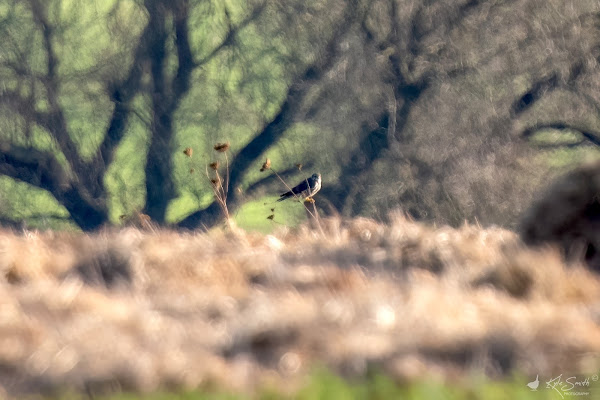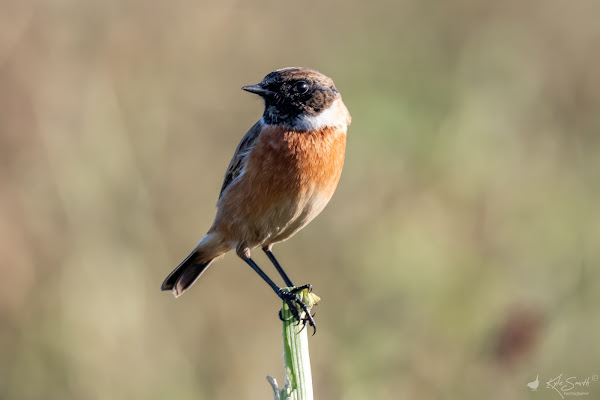So the wait goes on in my quest to see a merlin perched at close quarters. There was little on offer and in reach, so we stayed a little closer to home with the intention of seeing a merlin and perhaps follow up with an attempt for an early glaucous gull.
Without a clear plan to begin with we'd set off slightly in the wrong direction and had to make a correction for breakfast and then to our chosen site - there have been good views of merlin there in the past, but no reports so far this winter - this was a bit of a punt. When we arrived, we were instantly alarmed as there was a lot of work going on in the fields around and the perching stones from the previous year had been removed. We set up and watched fruitlessly for a while.
The merlin we sought is a small falcon: adult males have slate-blue backs with finely streaked underparts; females and immature birds have brown backs; all have a tail with narrow white bands. In the UK most merlins nest on the ground, which is unique to the UK population, although since the 1970s they have started to nest in conifer trees. The female builds the nest which is a shallow scrape in the ground lined with twigs, heather, and other plant matter.
Merlins are predators of birds including sparrows, thrushes, warblers and small to medium-sized songbirds. They will also eat small mammals such as bats, squirrels, mice and voles as well as reptiles and amphibians. The birds here were often seen lunching on meadow pipits and skylarks. Merlins can be seen in the UK all year round. In breeding season, they can be found in the uplands of Scotland, Wales, and northern England on moorland but also in conifer plantations. In winter they are joined by birds from Northern Europe and move to lowland areas as far as south-west England. This site held three birds last winter and is the reason why we'd chosen it today.
We decided to move down and along a footpath running between water pools on our right and the main field of interest on our left. We spotted meadow pipits and skylarks, plus partridges out in the scrub. The habitat still felt right although visually the area had changed. Eventually we worked back to the car and on, to try instead for a house sparrow which this spot is known for. We stopped to scan across other pools along the lane and were joined by a local birder. We said where we were headed, and he said he regretted to inform us that their winter population appeared to have been lost - another casualty.
As we searched for other birds of interest a stonechat popped above a hedge, quickly dropping from view and then another appeared on the embankment to our left. The lapwings got up and a sparrowhawk flew through behind - there was another raptor in the sky but heading away from us - seemed a little large for a merlin - perhaps another sparrowhawk?
The local birder was a nice chap and when we told him about our search, he said that he'd seen a merlin earlier. Initially he was blasé about it but shortly after, showed us some photos he'd digiscoped on his phone - the merlin perched on a post eating a skylark. I know we'd just met him, but I hated him already (😂). We birded with him for another quarter of an hour and as he left, we picked out song thrushes, Cetti's warbler, yellow-legged gull and a kestrel.
We made back to the car - the direction of the spot he'd observed the merlin. We started our search again along the footpath with renewed purpose. I was drawn to a small low shrub and there on the left side was a bird - I focussed on it and as it moved, I saw it was a raptor - a merlin (f). It hopped around the foot of the scrub/shrub and briefly showed a little higher. Kev got his scope on it and took some video - wait as we might it didn't budge and mostly faced away, preening.
Eventually we decided to try and locate the spot where the bird had been feeding and as we walked, we could still see the merlin until it took to the wing and flew below the ridge. I managed to pick it out again against the far trees and too distant for anything but record shots.
We eventually located the spot he must have been scoping from and now have a clear idea should we ever take the opportunity again.
Our quest had been partially successful, found the target bird (lovely) but not views at close quarters - other raptors are available.
On the way home we dropped into a spot well known for white-wingers and met rather a nice local birder who visits almost every day. He hasn't seen anything yet and we didn't while we were there.






No comments:
Post a Comment